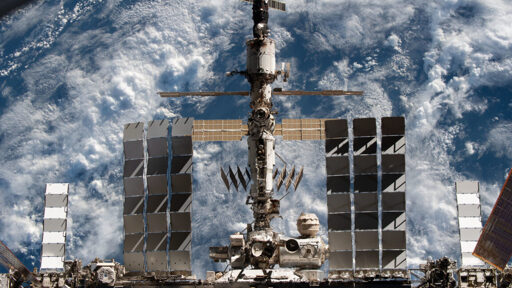The transfer tunnel, known by the Russian acronym PrK, connects the Zvezda module with a docking port where Soyuz crew and Progress resupply spacecraft attach to the station.
Air has been leaking from the transfer tunnel since September 2019. On several occasions, Russian cosmonauts have repaired the cracks and temporarily reduced the leak rate. In February, the leak rate jumped up again to 2.4 pounds per day, then increased to 3.7 pounds per day in April.
“The Russian position is that the most probable cause of the PrK cracks is high cyclic fatigue caused by micro-vibrations,” Cabana said on November 13. “NASA believes the PrK cracks are likely multi-causal, including pressure and mechanical stress, residual stress, material properties, and environmental exposures.”
Crew members aboard the space station are keeping the hatch leading to the PrK closed when they don’t need to access the Progress cargo freighter docked at the other end of the transfer tunnel. Russian cosmonauts must open the hatch to unpack supplies from the Progress or load trash into the ship for disposal.
As a precaution, Barratt said space station crews are also closing the hatch separating the US and Russian sections of the space station when cosmonauts are working in the PrK.



Fill the ISS with water and you’ll be able to see the leak.
This is probably the dumbest thing I’ve heard. You clearly have no idea what you’re taking about. To find the leak they need to spray the outside with soapy water. If that doesn’t work the next step is to put the ISS in a bathtub and fill the bathtub with water
Idiot. You obviously have no idea about the logistics of launching a bath into space. You’d need to send a bucket on a rocket (aero dynamic).
Put the ISS into the bucket, fill with water, then squeeze the ISS and look for bubbles.
Fucking fools. Just use a robotic arm to bend the whole suspect section. You’ll see the cracks open up as you flex it back and forth, and can spray some flex seal in the cracks. Seriously, try a little bit.
Brainless hemroids! Shmear the conspicuous gelatinous substance from front to back, always from front to back. Freshen & powder, and wrap her back up before she starts spewing like a little lad.
Great now there’s an 1800’s sailor on the space station.
I’m gonna show you ninnies how to really skip this boat
What a bunch of morons. Just hang some clothes around the ISS and if they wave you’ve found your leak. No need to send anything because astronauts already have clothes up there …
You all are fools, all this time finding the leak and none of you brought the tire patch
Clearly you’re thinking with your feet, because if you used your brain you’d know you bring the ISS to the bathtub, not the other way around
Ah, so after the ISS deorbit vehicle dunks it in the South Pacific, we can patch the hole and put it on the ISS reorbit vehicle. Right?
You’re all fools.
All you need to do is shield the exterior of the section, seal, depressurize, and bring to room temperature, then fill sufficiently with the soapy water.
They need two halves of a large enough tube with a valve in one of them, and something to interface between the ISS and the addition.
Just cover the exterior with soapy water